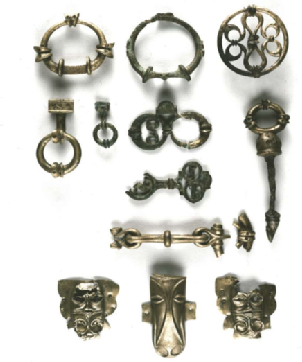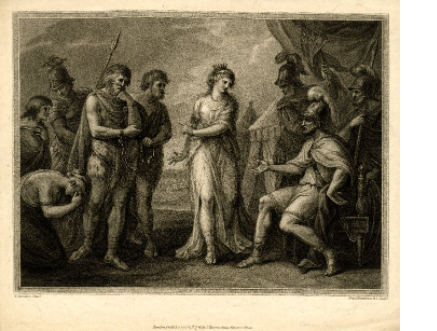Cartimandua and the Brigantes
The Brigantes

The Brigantes were were either one large tribe or a confederation or alliance of smaller tribes, who controlled a vast geographical area of northern England centred in what is now known as Yorkshire and often referred to as Brigantia. They were quite possibly the largest tribe in Britain and although there are no written sources to tell us anything about them prior to the Roman invasion, there is plenty of archaeological evidence from settlements in the area which show continued occupation from the early Iron Age.
One piece of information we do have is from the Roman author Seneca, who says that they carried dark blue shields. This line appears in a satire called Apocolocyntosis, and is part of a mock funerary lament for the emperor Claudius.
It’s likely that they were named after the deity Brigantia, who was a personification of the tribe and their protector. There are several altars to Brigantia, mostly in the north, and these were set up not just by native British people, but also Gauls and Romans. Brigantia was represented iconographically as being similar to Minerva or Victory or may have been conflated with them. This integration of British and Roman beliefs was typical of the period.
The geographer Claudius Ptolemy (ca.AD100-170) wrote of the Brigantes as a people in Ireland also, where they could be found around what is now Wexford, Kilkenny and Waterford, and Strabo (another Greek geographer born around 64BC) placed the Brigantii in the region of the Alps. This suggests that the goddess after whom the various tribes were possibly named was worshipped throughout Europe.
The territory of the Brigantes in Britain was bordered by that of the Votadini to the north, the Carvetii to the northwest, the Parisii to the east, and the Corieltauvi and the Cornovii to the south.The Carvetii, who occupied what is now Cumbria, may have been a sub-tribe of the Brigantes.
Stanwick
 Stanwick Iron Age Fortifications (also known as 'Stanwick Camp'), is a huge Iron Age hill fort in Richmondshire, North Yorkshire. It comprises over 9 kilometres of ditches and ramparts enclosing approximately 300 hectares (700 acres) of land
Stanwick Iron Age Fortifications (also known as 'Stanwick Camp'), is a huge Iron Age hill fort in Richmondshire, North Yorkshire. It comprises over 9 kilometres of ditches and ramparts enclosing approximately 300 hectares (700 acres) of land
It is possible that Stanwick was the stronghold of Venutius or Cartimandua (see below), or perhaps of them both for a brief time before their disagreement and separation some time after AD51. Either way, this was one of the most important settlements in Brigantia.
The Stanwick Hoard
In 1845 a hoard of 140 metal artefacts known as the Stanwick Hoard were found half a mile from Stanwick Camp at Melsonby. The hoard included four sets of horse harness for chariots and a decorative horse head now housed in the British Museum. Some of these items are pictured right. The decorative horse head (bottom centre) is only about 10cm long and is made of a copper alloy. It was possibly an attachment to a wooden object, perhaps a bucket.
Who was Cartimandua?
Cartimandua was of very high birth and was referred to as the queen (regina) of the Brigantes by the Roman author Tacitus (Histories 3.45). It is highly likely that she was a hereditary ruler, and her name is of Celtic origin and a compound, thought to mean “white-filly”. As for her position of queen, or the rulers of the Brigantes as kings and queens, there is some evidence for other native British tribes using the Latin word “rex” which means king, on coins which pre-date Britain becoming a Roman province, so this suggested that power and rule lay in the hands of individuals, but there are also coins which have pairs of names, so there was obviously differences in the setup of power and governance.
Although much less than Boudica, she is an important figure and provides an interesting case study for looking at relations with Rome in the early period of post Roman conquest, and for considering the place of women in the ancient world. Unfortunately nothing is known of her life other than what is told in the Roman literary sources from AD 51-69 (Tacitus Histories, 3.45 and Annals, 12.36 and 12.40) and this - as with Boudica - is always problematic. We must always remember we are viewing these figures through the lens of the Romans, with all the inaccuracies and exaggerations or simple bias that this entails.
The relations between Rome and the Brigantes seems to have been a positive one. As we have seen, the Romans created mutually beneficial relationships with the local elite in provinces as a means of asserting and maintaining control/peaceful relations It is thought that Cartimandua effectively had a “client-queen” type of relationship with the Romans, although it may not have been formalised as such; there was certainly some form of treaty between the two sides which benefitted both. This capitulation of the Brigantes to Rome may have occurred very early on. It is possible that Cartimandua may have been one of the 11 “kings” of Britain who surrendered to Claudius at Camulodunum (Colchester) in 43 CE. This is recorded in an inscription from the triumphal arch of Claudius in Rome, which was dedicated in 51 CE, to commemorate his victory. No names are recorded in the inscription and there is no mention in the literary sources of who the kings were so it cannot be known if Cartimandua was among them.
The Caratacus Affair

Caratacus was king of the Catuvellauni tribe in the south-east of England, and had been at the heart of the resistance against the Roman invasion in AD43, alongside his brother Togodumnus, who was killed early in the fighting. You can read about Caratacus in more detail here.
Caratacus lost the south-east and retreated to south Wales, where the Silures, who were extremely anti-Roman, accepted his leadership. They followed him into war against the new Roman governor, Publius Ostorius Scapula, who took up his position in AD47. Scapula defeated them and Caratacus fled. Caratacus took refuge with the Brigantes, but Cartimandua handed him over to the Romans (51 CE). The picture to the left shows an imagining of this scene by Francesco Bartolozzi in a print called "Caractacus, King of the Silures, deliver'd up to Ostorius, the Roman General, by Cartismandua, Queen of the Brigantes."
Caratacus and his family were taken to Rome and paraded in Claudius’ triumph, but some honour was accorded to him on account of his lineage and rank, as this reflected on Claudius’ achievement. Caratacus was given the chance to speak to the Senate, and in an impassioned speech he asked for clemency, and Claudius pardoned him and his family.
Cartimandua after Caratacus
Cartimandua's handing of Caratacus over to Rome would clearly have consolidated the good relations between the invaders and the Brigantes. But trouble was on the horizon.
As noted above, the surviving sources which describe the events involving Cartimandua, come from the two historical works by the famous Roman author, Tacitus: Histories and Annals. The main passages which refer to Cartimandua are: Histories, 3.45 and Annals, 12.36 and 12.40. From these we hear of the events surrounding Cartimandua after the Caratacus affair and which revolve around two figures - Venutius and Vellocatus.
From Tacitus we learn that one Venutius was married to Cartimandua for some time prior to the Caractacus event. He may well have been a leader of another tribe and their marriage could have been an alliance which strengthened Cartimandua’s hold on power. After Caratacus was handed over, Cartimandua prospered but at some point soon after, between AD51 and AD57, she and Venutius divorced Cartimandua married Venutius’ armour-bearer Vellocatus, and shared power with him. Tacitus says Cartimandua captured some of Venutius family (Annals 12.40); to which Venutius responded by attacking her. Cartimandua then appealed to the Romans.
It is probable that Cartimandua's handing over of Caratacus to the Romans was unpopular among some of the tribes and her own people. So the rejected Venutius no doubt used this anti-Roman sentiment to incite rebellion against her. He set about building alliances with other tribes, ready to invade Brigantia, but the Romans sent cohorts to defend their client queen. The sides were evenly matched until Caesius Nasica arrived with the IX Legion Hispana, and defeated Venutius (Annals 12.40). Cartimandua was lucky and narrowly escaped being captured by the rebels, thanks to the intervention of the Roman soldiers. After this Venutius bided his time until 69AD when the death of Nero resulted in a period of great political instability in Rome. Venutius seized the opportunity to launch another attack on Brigantia. This time when Cartimandua appealed for help from the Romans, they were only able to send auxiliary troops (Histories 3.45). What happened to Cartimandua we do not know. It is possible that she fled to the newly built Roman fort at Deva (Chester) and abandoned Brigantia to Venutius, who ruled briefly until the Romans finally ousted him.
Cartimandua provides an important and valuable insight into the fact that female rule was acceptable in native British society – in contrast to the Roman view of female rule being humiliating. She also provides a contrast to Boudica in that Cartimandua accepted Roman domination/rule and worked with it to her own personal advantage, but also to protect and secure the safety of her people.
